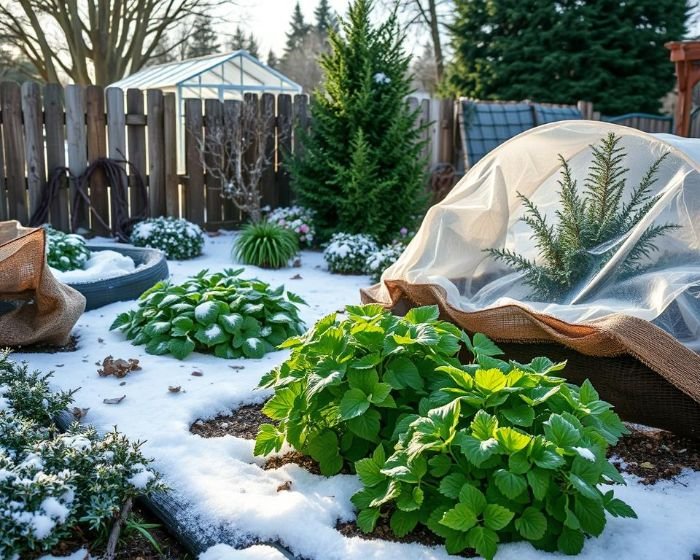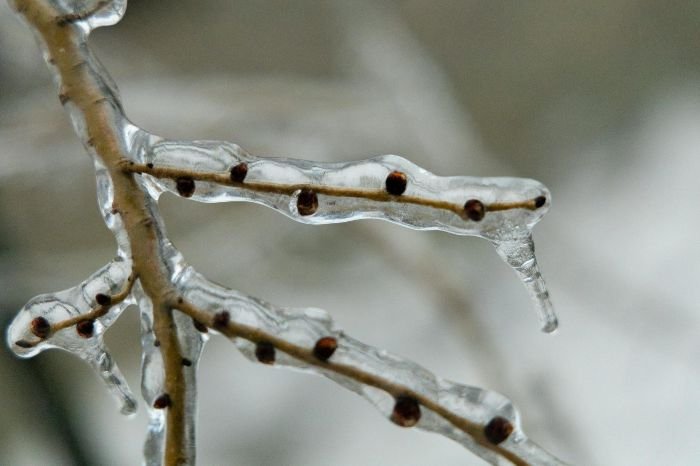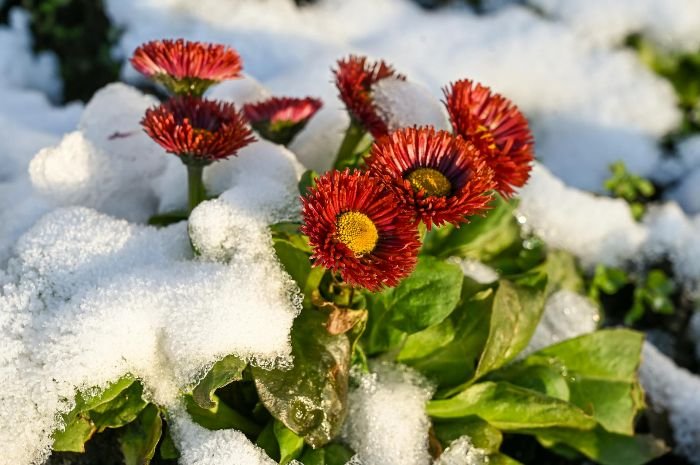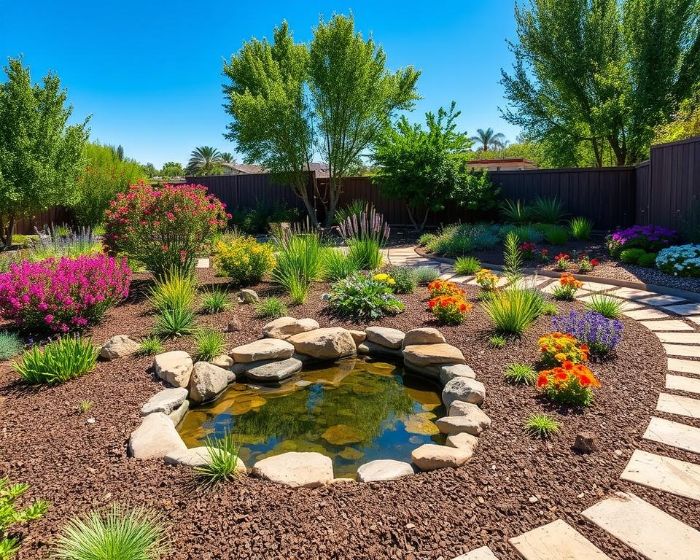Updated October 20, 2025
One calm night can undo weeks of growth. Frost doesn’t announce itself – it slides in silent, turning firm leaves limp by sunrise.
Protect plants from frost with a quick, pre-dusk setup that traps warmth where it forms and keeps ice from touching foliage. The difference between wilt and survival comes down to minutes of timing and how you seal the ground edge.
A few smart placements before dark let you wake to green instead of gray, saving early blossoms and the effort behind them.
Key Takeaways
- Catch frost before it forms by watching evening air signs
- Trap ground warmth early so soil works like a heater
- Create air gaps that stop ice from printing on leaves
- Use walls and stone to push warmth back into beds
- Avoid the late-night scramble that costs plants their edge
Table of Contents
Know When Frost Is Likely – Forecast Triggers and Cold Spots
A clear, still evening can pull heat out of a yard fast, so garden frost protection starts with reading the night ahead. Work off numbers and site cues, then act only when the risk crosses your threshold.
Risk bands that prompt action
A light frost becomes likely when the forecast low is 36-33°F with wind under 5 mph and clear sky. A hard freeze threatens at 32°F or below. If the dew point sits within about 2°F of the forecast low, expect stronger radiational cooling because the air can no longer hold extra heat.
Use a single checkpoint near sunset – compare the forecast low, dew point, and wind. If two of the three point to cooling, prepare covers before dark. This works because calm, dry air loses heat faster to the open sky than humid, breezy air.
I often notice that ground-level thermometers read 2-5°F colder than porch-height readings on calm, cloudless nights.
Where cold settles in a yard
Cold air drains and settles, so the lowest lawn pockets and bed edges below paths chill first. Open-sky exposures radiate heat fastest, while south walls and fences return stored warmth into the first hours after dark.
Walk the site at dusk and pick three checkpoints – a low spot, an open center bed, and a wall-adjacent bed. If the low spot falls fastest and the open bed follows within an hour, plan to protect both. This pattern reflects cold pooling and unimpeded sky exposure.
Quick confirmation checks
Set one thermometer at 5 ft and another 2 in above soil. When the spread grows beyond 2°F by early evening, the surface layer is decoupling from the air mass and plants are at higher risk.
Use touch cues that correlate with cooling – mulch feels dry and cool, exposed stone loses warmth quickly, and leaf surfaces turn cool to the touch before the air reading drops. Repeat checks every 45-60 minutes until covers go on or the wind picks up. Small time windows matter because radiational loss accelerates after sunset, then slows toward dawn when humidity rises.
Close with one rule – if the numbers line up and the cold pocket confirms it on-site, cover early. Waiting for visible frost wastes the calm hour when heat is still stored in soil and hardscape.
Pick the Right Cover – Frost Cloth, Sheets, Plastic, and Anchors
A calm frosty night punishes exposed leaves, while a well-sealed cover holds the day’s warmth near the soil. Choose material for breathability and temperature gain, then secure the edges so air under the cover stays trapped until sunrise.
What changes under a cover
Covers slow radiational heat loss by creating a warmer boundary layer over the bed. Breathable fabrics keep humidity moving so ice does not form on leaf surfaces, while non-porous films trap heat but also trap moisture.

Expect different gains by material. Breathable row fabric typically lifts surface temperatures about 2-4°F on a clear night. A double layer on hoops can add roughly 3-6°F. Non-porous plastic can raise temps more in calm air, yet condensation that freezes against foliage causes damage, so plastic should never touch leaves. Burlap moderates wind and light frost but sheds water slowly, so it performs best when leaves start dry.
How to secure edges
Heat leaks from gaps first, not through the fabric. A full perimeter seal with soil, sandbags, or bricks limits warm air exchange.
Set supports so fabric sits 1-3 in above foliage. Anchor the perimeter every 2-3 ft and at all corners. Add a mid-span tie or clip on longer runs so fabric does not sag onto crop tips by midnight. This spacing holds shape through typical backyard gusts so the warm pocket stays intact until morning.
Pro tip – Pre-stage short fiberglass rods or wire hoops in fall and store a bag of clips with the fabric. Covers go on in two minutes, which matters when temperatures drop faster than forecast.
When sheets are enough
Household cotton works on a single light frost when leaves are dry and beds are short. Use supports and seal the hem to the soil. Cotton breathes, so leaf wetness stays lower than under plastic, but its temperature lift is modest and depends on weave density.
Skip cotton when a hard freeze is forecast, when wind is expected to rise overnight, or when the fabric cannot clear tall crowns. Failure signals are easy to read at dawn: ice prints where fabric touched leaves, wet blotches under plastic, or chilled tips where the hem gapped. In those cases, switch to purpose-made fabric on hoops and seal the edge fully.
| Material | Breathable | Typical °F gain | Reuse span | Condensation risk | Best use |
|---|---|---|---|---|---|
| Purpose-made row fabric | Yes | 2-4 | Many nights | Low | Most beds, light to moderate frost |
| Double layer on hoops | Yes | 3-6 | Many nights | Low-medium | Tender crops, calmer nights |
| Cotton sheet on hoops | Yes | 1-3 | Few nights | Low-medium | One light frost, short beds |
| Plastic film on hoops | No | 3-7 | Several nights | High | Only with air gap and morning venting |
| Burlap wrap or panel | Yes | 1-2 | Many nights | Low | Shrubs and small trees, wind break |
Material choice controls heat, moisture, and speed of setup. Pick the lightest breathable option that clears foliage and that you can seal completely in your yard layout.
Night-Of Routine to Protect Plants From Frost
Light fades, air turns glassy-cold, and you have a 60-90 minute window to lock in the day’s warmth. Work in a set order so heat stays in the soil and covers go on before radiational cooling accelerates.
Afternoon prep that stores heat
Moist soil holds more energy than dry soil because water has higher heat capacity. Give beds a thorough soak early enough that foliage dries before dusk; wet leaves lose heat faster. Aim to moisten the top 2-3 inches, then let surfaces dry while sun is still up.
Group containers tight against a south or west wall to pick up reflected warmth. Pull pots off metal stands that let cold air sweep under. Dark stones or full water jugs tucked between pots act as small thermal masses and return a few degrees near dawn.
I often notice that beds watered 2-3 hours before sunset keep surface readings 1-2°F warmer at nightfall than beds watered at the last minute.
Evening sequence after you chose a cover
Start 45-60 minutes before sunset so trapped air is still warm. Set supports so fabric clears foliage, drape the cover, then seal the perimeter to the soil. Warm air rises under the cover and cools more slowly than exposed air, so an early seal pays off through the first half of the night.
Check for contact points with a quick flashlight pass. Lift fabric off tender crowns with extra clips or a short hoop. Place a small thermometer probe 2 inches above the soil inside one bed and confirm the reading rises a couple of degrees within 15 minutes; if it does not, look for gaps along the hem.

Adjust for wind or slope
Wind strips heat fast. If the forecast calls for 8-12 mph overnight, add extra weights on the windward side every 1-2 ft and a second tie at mid-span to prevent fabric collapse. Use a second fabric layer only when air is calm so the trapped layer stays undisturbed.
On sloped ground, seal the upslope edge first so warmer air does not drain out from under the cover. Where cold air collects in a low pocket, extend the cover 6-12 inches beyond the bed and weight the skirt so the warm bubble stays in place through dawn.
Night-of checklist:
- Water early so leaf surfaces dry before dusk.
- Cluster containers near a heat-reflecting wall.
- Start covers 45-60 minutes before sunset.
- Lift fabric off crowns and seal the hem fully.
- Add wind-side weights if forecast is 8-12 mph.
- Verify inside temperature rise within 15 minutes.
Finish with one rule of thumb – if you can still feel residual warmth in the soil at sunset, you are on time; if the surface already feels cold to the touch, cover immediately and reinforce gaps first.
Multi-Night Freeze Plan – Tunnels, Cold Frames, Thermal Mass
A clear three-night snap can flatten tender growth unless you bank daytime heat and hold it. Use compact structures with a tight seal at dusk and a controlled vent each morning so plants ride out repeated lows without leaf scorch.

Match structure to the job
Choose the lightest build that clears foliage and holds form. Low tunnels span long beds quickly and accept layered fabric. Cold frames concentrate heat for greens and starts, with lids that meter airflow. Mini hoops over single rows bridge the gap when space is tight.
Aim for a 6-12 inch air gap above the tallest crown so chilled fabric never touches tissue. Wider spans need cross ties so covers keep shape when frost forms overnight. The goal is the same each night – trap ground heat, avoid contact, and keep the pocket intact until sun returns.
Add passive heat
Thermal mass smooths temperature swings because water and stone release stored energy slowly. Place dark water jugs or a tightly capped barrel inside frames where sun hits mid-day. Two to four gallons per 10 sq ft raises predawn readings by about 2-4°F on clear nights.
Paint containers a dark color for faster charging. Set flat pavers or bricks along the interior perimeter to return warmth to leaf height. Arrange mass where it sees sun and where airflow is clear so warming reaches foliage, not just the floor.
I often notice that a row of dark one-gallon jugs along the north wall of a frame lifts the probe at leaf height by 3°F right before sunrise on cloudless runs.
Vent each morning without heat loss
Moist air under covers condenses by dawn; venting dries foliage so cells do not rupture when sun hits. Crack lids or lift leeward edges once outside air climbs above 34-36°F, then widen openings as interior humidity drops. Close again well before sunset so the structure preheats for night two.
Watch for failure signals: dripping lids, gray watermarks on leaves, or fabric sag from frost weight. Correct by adding a small prop to increase gap, tightening spans, or spacing thermal mass to improve circulation. Vent in short cycles on windy mornings so plants do not chill while leaves are still damp.
| Structure | Typical °F gain | Setup time | Cost range | Vent need | Best for |
|---|---|---|---|---|---|
| Low tunnel with fabric | 3-6 | Fast | Low | Moderate | Long beds, salad rows |
| Low tunnel double layer | 5-9 | Moderate | Low-medium | Moderate | Tender crops in calm spells |
| Mini hoop over single row | 3-5 | Fast | Low | Low-moderate | Narrow beds, quick installs |
| Cold frame with lid | 5-10 | Moderate | Medium | High | Seedlings, leafy greens |
| Frame plus water mass | 6-12 | Moderate | Medium | High | Multi-night freezes, sun exposure |
Pick the structure you can deploy and vent on time for three mornings in a row. Reliability beats maximum gain when the run goes past one night.
Morning Recovery and Reset – Uncover, Assess, Prepare Tonight
Sun hits cold covers and moisture flashes on leaves, so the first minutes after sunrise decide whether tissue rebounds or collapses. Morning recovery is part of garden frost protection because timing and airflow control thaw rate and leaf hydration.

Safe uncovering window
Vent first so trapped moisture escapes before full removal. Crack lids or lift the leeward edge once outside air rises a couple of degrees above freezing and interior leaf surfaces feel dry to the touch.
Wait 15-30 minutes, then remove covers in stages. Slow thaw prevents cells from rupturing as light energy rises. If wind is brisk, vent in short intervals to dry foliage without chilling it again.
Pro tip – If foliage feels rigid or glassy at dawn, shade plants for 30-45 minutes with a board or fabric to slow warm-up before uncovering.
Read plant injury fast
Look for firm, green tissue with normal sheen. That tissue is alive and will perk up as temperatures climb. Damaged areas turn dull, water-soaked, or limp within a few hours, then darken as membranes fail.
Check stems and crowns, not just leaves. A living crown feels firm and resists thumb pressure, while injured crowns feel soft or mushy. Hold pruning until 24-48 hours after the event because marginal tissue often recovers once internal fluids rebalance.
Reset for the next cold night
Dry covers in the sun and roll them loosely so fibers do not mat and lose loft. Store anchors in a single tote and stage hoops at bed ends to cut setup time.
Reposition containers toward sun-warmed walls and close any low gaps you noticed during the night. Replace sagging clips, add a few more perimeter weights where airflow sneaked under, and mark the cold pocket you confirmed today so you prioritize it at dusk.
Morning reset checklist:
- Vent first, then remove covers after 15-30 minutes.
- Confirm live tissue by firmness and color, delay pruning 1-2 days.
- Dry and stage covers, hoops, and weights for fast redeployment.
- Move containers to warmer exposures, fix known edge leaks.
- Flag the lowest pocket for first coverage tonight.
Finish tight and simple: dry foliage, staged gear, and a marked cold pocket cut the next setup to minutes and reduce losses on the second and third frost hits.
Practical Wrap-Up
Treat frost control like a short season with a clear routine. Stage gear in one tote, log two numbers each evening, and run the same checks after sunrise. The routine matters because consistency keeps small losses from stacking across a week of cold nights.
Build a simple cadence. Two weeks before your average first frost, pre-fit hoops, cut covers with a 12-18 inch skirt, and label clips and weights by bed. Each frost night, record forecast low and dew point at sunset, then spot-check one low pocket with a probe at 2 inches. If the forecast low is 36-33°F and wind is under 5 mph, prep covers before sundown. If wind is 8-12 mph, add wind-side weights every 1-2 ft. Replace fabric when it sags on hoops or when a light tug opens a tear.
Watch for failure signals and fix them the same morning. Ice prints on leaves mean contact points formed overnight – raise the span with an extra hoop. Wet blotches under plastic mean trapped moisture – switch to breathable fabric and vent earlier. A flat temperature line inside a covered bed means leaks at the hem – add weights along the upslope edge before the next night.
- Fix contact points and edge leaks the next morning
- Stage one tote per bed with fabric and weights
- Pre-fit hoops and cut a 12-18 inch skirt
- Log forecast low and dew point at sunset
- Probe one low pocket 2 inches above soil
FAQ
At what temperatures do tender crops like tomatoes and peppers need covering?
Cover when the forecast low is 36-33°F under clear, calm conditions and always at 32°F or below. If the dew point sits within 2°F of the forecast low, act at the higher end of that range because radiational cooling accelerates. For blossoms or new transplants, use an earlier trigger at 37-35°F to protect pollen viability.
Is frost cloth better than a sheet for overnight protection?
Frost cloth breathes and keeps leaf surfaces drier, which reduces ice formation on contact points, and it maintains loft after repeated folds. A sheet can work for one light frost on short beds, but its temperature lift depends on weave density and it sags faster with moisture. If wind is forecast or crowns are tall, choose purpose-made fabric on hoops.
How do you protect your garden from frost when you are away overnight?
Stage covers and anchors before leaving, drape fabric over pre-set hoops, and seal the perimeter fully. Place water jugs in sun-exposed spots to add passive heat and crack a vent on frames the next morning by setting a simple prop that a neighbor can lower at dusk. Ask someone to remove covers once outside air rises above 34-36°F to prevent midday scorch.
Can you use plastic to protect plants from frost safely?
Yes, if plastic sits on hoops with a clear air gap and never touches foliage. Use clamps along the windward edge, and vent as soon as interior humidity condenses on the film or when outside air reaches 34-36°F. Remove or raise the film when sun strengthens to avoid leaf scorch and trapped moisture.
What happens if covers go on after dark?
Heat stored in soil and hardscape has already dropped, so interior temperatures rise less and tender tips may chill even under fabric. Add thermal mass near crowns and seal gaps immediately to salvage a few degrees. Expect more leaf edge damage at dawn and plan a slower thaw with brief shading.
How often should you water before a frost event?
Water once in the afternoon of a frost forecast so the top 2-3 inches are evenly moist, then let leaf surfaces dry before sunset. Skip extra watering on back-to-back nights unless soil has dried; overwatering cools roots and slows rebound the next day.
What is the quickest way for container gardeners to ride out a hard freeze on a balcony?
Cluster pots tight against a south or west wall, elevate off metal rails, wrap containers with breathable fabric, and place dark water jugs between pots to return heat near dawn. Use a single layer for a light freeze and a second breathable layer only on calm nights to avoid fabric collapse.
Does a light breeze reduce frost risk enough to skip covers?
A breeze around 5-8 mph mixes air and often prevents surface temperatures from dropping below the air reading, so marginal frost may not form. If wind falls toward calm after sunset or the site has a known low pocket, keep covers ready and apply when the breeze drops and the forecast remains 36-33°F.










